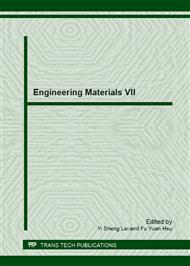[1]
E.R. Hwang, J.W. Park, Y.D. Kim, et al. Effect of alloying elements on the copper-base anode for molten carbonate fuel cells[J]. Journal of Power Sources, 1997, 69: 55-56.
DOI: 10.1016/s0378-7753(97)02566-4
Google Scholar
[2]
Qiao Jichao, Xi Zhengping, et al. Reviews on compressive behavior of porous metals[J]. Rare Metal Materials and Engineering, 2010, 39(3): 561-566.
Google Scholar
[3]
J.M. Andǘjar, F. Segura. Fuel Cells: History and updating. A walk along two centuries[J]. Renewable and Sustainable Energy Reviews, 2009, 13: 2309-2322.
DOI: 10.1016/j.rser.2009.03.015
Google Scholar
[4]
Bode'n A, Lindbergh G, Sparr M. Investigation of the porous nickel anode in the molten carbonate fuel cell[A]. In: Proc. 7th Int. Symp. Molten Salts Chemistry & Technology, Toulouse; 29 Aug-2 Sep (2005).
DOI: 10.1149/1.1359195
Google Scholar
[5]
A. Dahou, J.F. Shao, M. Bederiat. Experimental and numerical investigations on transient creep of porous chalk[J]. Mechanics of Materials, 1995, (21): 147-158.
DOI: 10.1016/0167-6636(95)00004-6
Google Scholar
[6]
Gong Mingming, Tan Lili, et al. Finite element analysis on compressive property of new porous magnesium[J]. Acta Metallurgica Sinica, 2008, 44(2): 237-242.
Google Scholar
[7]
Yun-Sung Kim, Kwan-Young Lee, Hai-Soo Chun, Creep characteristics of porous Ni/Ni3Al anodes for molten carbonate fuel cells[J] . Journal of Power Sources, 2001, 99(1-2): 26-33.
DOI: 10.1016/s0378-7753(00)00689-3
Google Scholar
[8]
Jung-Ho Wee. Creep and sintering resistance of a Ce added anode electrode for molten carbonate fuel cell[J]. Materials Chemistry and Physics, 2006, 98 : 273–278.
DOI: 10.1016/j.matchemphys.2005.09.018
Google Scholar
[9]
Dohwon Jung, Insung Lee, Heechun Lim, et al. On the high creep resistant morphology and its formation mechanism in Ni–10 wt. % Cr anodes for molten carbonate fuel cells[J]. Journal of Materials Chemistry, 2003, 13: 1717-1722.
DOI: 10.1039/b300745f
Google Scholar
[10]
Jung-Ho Wee, Dae-Jin Song, Chang-Sung Jun, et al. Evaluation of Ni–Ni3Al(5 wt. %)–Al(3 wt. %) as an anode electrode for molten carbonate fuel cell Part I: Creep and sintering resistance[J]. Journal of Alloys and Compounds, 2005, 390: 155-160.
DOI: 10.1016/j.jallcom.2004.06.103
Google Scholar
[11]
T.A. Venkatesh and D.C. Dunand. A model for the longituninal primary creep of a long-fiber composite[J]. Acta Materials, 1999, 47 (17): 4275-4282.
DOI: 10.1016/s1359-6454(99)00308-0
Google Scholar
[12]
Zang Chunyong. Research on the mechanical properties of nickel alloy porous materials[J]. Journal of Shanxi University of Science & Technology, 2009, (3): 9-36.
Google Scholar


